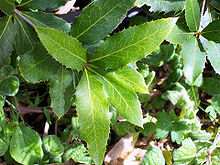Eidothea hardeniana
| Eidothea hardeniana | |
|---|---|

| |
| Nightcap Oak leaves at Royal Botanic Gardens, Sydney | |
| Scientific classification | |
| Kingdom: | |
| (unranked): | |
| (unranked): | |
| Order: | |
| Family: | |
| Subfamily: | |
| Genus: | |
| Species: | E. hardeniana
|
| Binomial name | |
| Eidothea hardeniana | |
Eidothea hardeniana, commonly named Nightcap Oak, is a species of trees up to 40 m (130 ft) tall, of the plant family Proteaceae, which botanist Robert Kooyman recognised as a new species only recently in 2000.[2][4][5] The species has an official listing as critically endangered on the Australian Commonwealth EPBC Act and as Endangered on the NSW Threatened Species Act.[1][4] The name hardeniana honours the botanist Gwen Harden. Phylogenetics studies now suggest it represents a basal branch of the Proteoid clade of the Proteaceae.
Distribution and habitat
The trees are only known to grow naturally in a single creek catchment in warm temperate rainforest in the Nightcap Range, northern New South Wales, Australia. They grow naturally in relatively poor, acidic volcanic soils, in an area of a high rainfall. Only around 100 wild plants are known.[2][5] Plants are in cultivation, including in the Royal Botanic Gardens, Sydney.
Description
E. hardeniana trees have pale lichen covered bark typical of many species in the Warm Temperate Rainforests. Often a ring of coppice shoots surrounds the base of an adult tree, coppice and seedling leaves have spiny marginal teeth, while adult leaves have no teeth.[2]
Flowers are cream in clusters and smell of aniseed.
Fruits are large and rounded with a yellow green skin and a hard nut inside. The walls of the nut are ribbed, a feature unique to this genus in the family. The seed has a white center and it probably contains poisonous cyanogenic compounds like some species of Macadamia.[citation needed] These toxins do not deter rodents from eating through the hard nut and devouring the seeds, limiting the regeneration of this plant.
Flower photos
-
un-opened buds
-
Flowers
-
Flowers
-
flower growing directly from the main stem
References
- ^ a b Eidothea hardeniana – Nightcap Oak, Species Profile and Threats Database, Department of the Environment and Heritage, Australia. Retrieved 14 Dec 2013
- ^ a b c d Weston, P. H.; Kooyman, R. M. (2002). "Systematics of Eidothea (Proteaceae), with the description of a new species, E. hardeniana, from the Nightcap Range, north-eastern New South Wales" (PDF). Telopea. 9: 821–832. Retrieved 10 Nov 2013.
- ^ "Eidothea hardeniana P.H.Weston & Kooyman". Australian Plant Name Index (APNI), IBIS database. Centre for Plant Biodiversity Research, Australian Government. Retrieved 10 Nov 2013.
- ^ a b NSW Department of Environment and Conservation (2004). National Recovery Plan for the Nightcap Oak (Eidothea hardeniana). Hurstville, New South Wales: Department of Environment and Conservation. ISBN 0-7313-6781-2. Retrieved 10 Nov 2013.
- ^ a b Weston, P. H.; Kooyman, R. M. (2002). "Eidothea hardeniana- Botany and Ecology of the 'Nightcap Oak'". Australian Plants. 21. Australian Plants Society: 339–342.
External links
- National Recovery Plan (PDF file)





